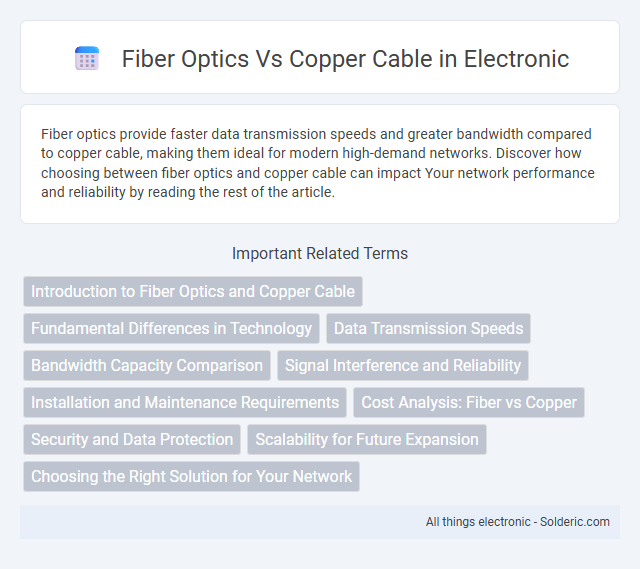Fiber optics provide faster data transmission speeds and greater bandwidth compared to copper cable, making them ideal for modern high-demand networks. Discover how choosing between fiber optics and copper cable can impact Your network performance and reliability by reading the rest of the article.
Comparison Table
| Feature | Fiber Optics | Copper Cable |
|---|---|---|
| Data Transmission Speed | Up to 100 Gbps and beyond | Up to 10 Gbps (Cat6a/Cat7) |
| Bandwidth | Extremely high, supports long distances | Limited, decreases over distance |
| Distance | Up to 40 km or more without repeaters | Up to 100 meters |
| Signal Interference | Immune to electromagnetic interference (EMI) | Susceptible to EMI and crosstalk |
| Durability | Fragile, requires careful handling | More robust and flexible |
| Cost | Higher initial installation cost | Lower initial cost, cheaper materials |
| Security | Highly secure, difficult to tap | Less secure, easier to tap signals |
| Use Cases | High-speed internet, long-distance communication | Local networks, short-distance communication |
Introduction to Fiber Optics and Copper Cable
Fiber optics use thin strands of glass or plastic to transmit data as light signals, offering high bandwidth and low signal loss over long distances. Copper cables transmit data using electrical signals through metal wires, commonly used for shorter distances with moderate bandwidth requirements. Fiber optics provide superior speed, reliability, and resistance to electromagnetic interference compared to copper cables.
Fundamental Differences in Technology
Fiber optics use light signals transmitted through glass or plastic fibers, enabling high-speed data transfer with minimal signal loss and immunity to electromagnetic interference. Copper cables rely on electrical signals transmitted through metal wires, which are more susceptible to signal degradation over long distances and electromagnetic noise. This fundamental technological difference results in fiber optics supporting greater bandwidth and longer transmission distances than copper cables.
Data Transmission Speeds
Fiber optics provide significantly higher data transmission speeds compared to copper cables, supporting bandwidths up to several terabits per second. Copper cables, such as twisted pair or coaxial, typically offer speeds limited to 10 Gbps under ideal conditions due to electrical resistance and signal degradation. Fiber optic technology uses light to transmit data, enabling faster, clearer, and longer-distance communication without electromagnetic interference.
Bandwidth Capacity Comparison
Fiber optics offer significantly higher bandwidth capacity than copper cables, supporting data transmission speeds up to 100 Gbps or more, compared to copper's typical maximum of 10 Gbps. This vast difference in bandwidth makes fiber optics ideal for data-intensive applications, long-distance communication, and future-proofing network infrastructure. Your choice of fiber over copper ensures faster, more reliable connectivity with less signal attenuation and interference.
Signal Interference and Reliability
Fiber optics offer superior resistance to electromagnetic interference (EMI) compared to copper cables, resulting in more reliable and consistent signal transmission over longer distances. Copper cables are susceptible to signal degradation and noise caused by EMI, which can affect data integrity and network performance. This enhanced immunity to interference makes fiber optics the preferred choice for high-speed, mission-critical communication networks demanding minimal latency and maximum uptime.
Installation and Maintenance Requirements
Fiber optics require specialized installation techniques such as precise splicing and careful handling to avoid damage, while copper cables are easier to install with standard tools and practices. Maintenance of fiber optic cables involves monitoring for signal loss and repairing delicate fiber strands, whereas copper cables often face issues like corrosion and electromagnetic interference that demand regular physical inspections and replacements. Your choice between fiber optics and copper should consider the complexity of installation and the long-term maintenance costs tailored to your network's needs.
Cost Analysis: Fiber vs Copper
Fiber optics generally have a higher initial installation cost compared to copper cable due to expensive materials and specialized equipment, but fiber's lower maintenance expenses and longer lifespan offer better long-term value. Copper cable costs less upfront but can incur higher expenses over time because of signal degradation, interference issues, and the need for frequent replacements or repairs. Your choice should consider both immediate budget constraints and future scalability requirements to optimize overall cost-efficiency.
Security and Data Protection
Fiber optics provide superior security and data protection compared to copper cables due to their resistance to electromagnetic interference and difficulty in tapping without detection. Copper cables are more susceptible to signal interception and electromagnetic interference, making data vulnerable to breaches. Your choice of fiber optics enhances secure data transmission, crucial for sensitive information and compliance with stringent cybersecurity standards.
Scalability for Future Expansion
Fiber optics offer superior scalability for future expansion due to their high bandwidth capacity and ability to transmit data over longer distances without signal degradation. Copper cables are limited by their lower bandwidth and susceptibility to electromagnetic interference, making them less suitable for growing network demands. Investing in fiber optics ensures your infrastructure can support increasing data loads and evolving technologies efficiently.
Choosing the Right Solution for Your Network
Fiber optics offer higher bandwidth and longer distance capabilities than copper cable, making them ideal for high-speed data transmission and large-scale networks. Copper cables are cost-effective and easier to install for shorter distances and less demanding applications, providing reliable performance in local area networks. Selecting the right solution depends on network size, required data speed, budget constraints, and environmental factors.
Fiber optics vs Copper cable Infographic

 solderic.com
solderic.com